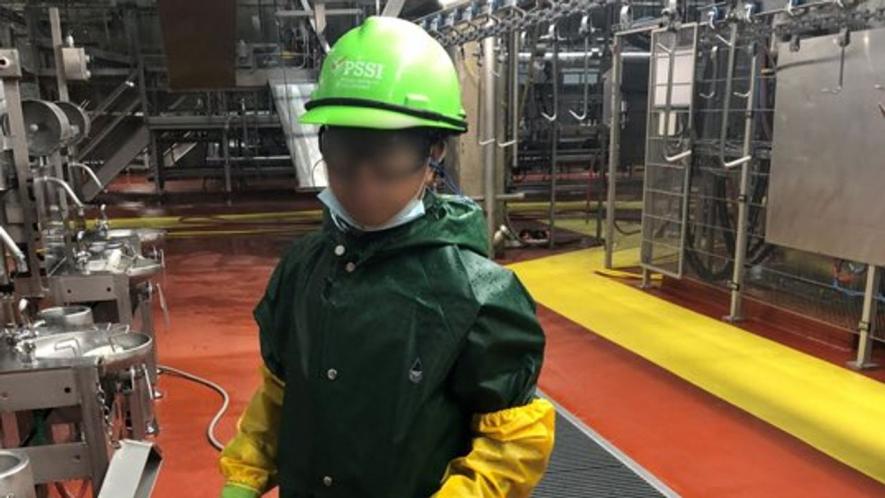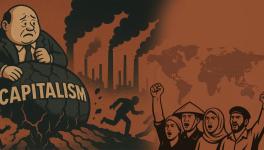US Has Child Labour Crisis. Lawmakers are Trying to Make it Worse

Packers Sanitation Services Inc., one of the largest sanitation companies for the meat processing industry was fined $1.5 million in February for hiring over 100 children in hazardous labor, cleaning equipment such as “skull-splitters” and “razor-sharp bone saws.” (Photo: US Department of Labor)
Lee en español aquí
Many assume that child labor in the US is a remnant of the past. In reality, child labor is a hidden crisis. Children of the working class are frequently exploited with devastating consequences, including injury and death. Child labor violations are on the uptick, with migrant children at special risk of being put into dangerous occupations at a young age. At the same time, lawmakers across the country, sponsored by industry giants, are trying to worsen the existing tragedy.
In Iowa, the State Senate just passed one of the most extreme pro-child labor bills in recent times. SF 167, introduced by State Senator Jason Schultz, lifts restrictions on hazardous work, extends work hours, and lowers the age for child workers serving alcohol to adults. 14 to 17-year-olds would be permitted to work in jobs previously prohibited to them, as long as they are part of an approved “training program.” But these “training programs” are unlike most, allowing younger children to work in “slaughterhouses, meatpacking or rendering plants; mining; operating power-driven metal forming, punching or shearing machines; operating band or circular saws, guillotine shears or paper balers; or being involved in roofing operations or demolition work.”
Perhaps the most egregious thing about the new bill is that it leaves employers off the hook if one of their child workers gets injured or even dies on the job. Companies are not civilly liable for injury or death, nor are child workers eligible for workers’ compensation. “A business that accepts a secondary student in a work-based learning program shall not be subject to civil liability for any claim for bodily injury to the student or sickness or death by accident of the student arising from the business’s negligent act or omission during the student’s participation in the work-based learning program at the business or worksite,” the bill’s text reads.
It’s as if the bill’s authors are acutely aware that younger kids driving to work longer hours makes children tired and accident-prone, specifically writing in, “A business that accepts a secondary student in a work-based learning program shall not be subject to civil liability for any claim for bodily injury to the student or sickness or death by accident of the student arising from the student’s driving to or from the business or worksite to participate in the work-based learning program.”
As More Perfect Union reported, Iowa’s SF 167 and the similar bills popping up across the country are being bankrolled by some of the most powerful lobbying groups for big business and employers who employ low-wage labor.
In conjunction with the wave of legislation, child labor as an issue has been increasingly brought to the forefront of public discourse. A TikTok video went viral this month, filmed by a Chick-fil-a customer incredulous at encountering a 13-year-old worker at the fast food restaurant. Months after a Reuters investigation revealed that a subsidiary of Hyundai was illegally exploiting migrant children in an auto plant in Alabama, the New York Times ran an expose on unaccompanied migrant children as young as 12 years old, illegally exploited by their employers, who were working dangerous jobs such as construction, often foregoing schooling. Hannah Drier, the journalist who broke the Times story, soon did a follow up, revealing that the Biden administration was repeatedly made aware of the migrant child labor crisis, but chose to do nothing. Packers Sanitation Services Inc., one of the largest sanitation companies for the meat processing industry was fined $1.5 million in February for hiring over 100 children in hazardous labor, cleaning equipment such as “skull-splitters” and “razor-sharp bone saws.” At least three of those children suffered burns from the chemicals used for cleaning.
The problem
From the beginning of the 21st century, child labor violations had been declining. Then, in 2015, they began to rise again. The Labor Department has reported an almost 70% increase in illegal child employment since 2018.
Meanwhile, the Biden administration refuses to properly enforce child labor laws. Following the meatpacking sanitation debacle, Agriculture Secretary Tom Vilsack sent what amounts to no more than a strongly worded letter to the meat and poultry industry, urging them to not use child labor. No threat of criminal charges for employers engaging in a criminal act, despite the fact that the US legal system is notorious for its harshness towards the working class.
Research has shown that working more than 20 hours a week has profound educational and behavioral effects on children, including a decline in school engagement.
Peoples Dispatch spoke to Angel, a 16-year-old Colombian migrant worker who lives in Jackson Heights, Queens. Angel works at an Italian restaurant from 4 PM to 11 PM on days he has school, 11 AM to 11 PM when he doesn’t. He crossed the US–Mexico border without his parents, and now is entirely responsible for every single one of his expenses. He is also responsible for paying the lawyers who are helping with his immigration process. Angel’s 47-hour workweek puts him just below the 48-hour cutoff for 16-year-old workers in New York City.
Angel does not have time to do homework, and his long hours at the restaurant leave him exhausted at school. “From my house I go here, to school, from school I go to work, and from work to home, every day,” he said. “And yes, it is exhausting, of course, but it is something I have to do.”
Child farmworkers especially at risk
Some of the most hazardous child labor in the US isn’t even illegal. In the farming sector, specifically, child labor laws are far more lenient. Under the Fair Labor Standards Act, children 12 and up can work unlimited hours outside of school hours in agriculture, and rules are even more lenient for children who work on their family’s farms. Kids aged 16 and 17 working in agriculture can do tasks listed as hazardous by the Labor Department, while for other industries the cutoff is 18.
Agricultural work is also one of the most hazardous occupations for kids. Conditions such as extreme heat and the use of dangerous farming equipment exacerbate injuries. Children as young as 12, too young to buy a cigarette, labor on tobacco fields across the US. Tobacco farming puts workers at risk of nicotine poisoning, called “Green Tobacco Sickness.” Children are three times more susceptible to developing cancer from pesticides, but are regularly exposed to such chemicals in the agricultural industry. Children under 16 are 12 times more likely to sustain injuries, including fatal ones, from ATVs, vehicles regularly used in farming. The Government Accountability Office reported that 100,000 child farm workers are injured on the job each year, and that children accounted for 20% of all worker deaths in the industry. 452 children died at work from 2003 to 2016. 52% of those deaths were in agriculture.
The scope of the problem is difficult to even quantify. It is estimated that 88% of child labor injuries in agriculture aren’t even included in these statistics, and that children sustain four times more injuries than are reported.
—
Some speculate that the reason that employers are just now bankrolling attempts to weaken child labor restrictions is to combat the growing reluctance of workers to return to low-wage, low-quality jobs after COVID-19.
During the height of the pandemic, the US government finally boosted social spending. Workers often opted to survive off boosted unemployment benefits, rather than risk their lives working for employers who would underpay them. As a result, they have not had to rely as much on whatever employment is available, regardless of conditions or wages. Employers have erroneously called this the “labor shortage,” although there is no shortage of workers willing to work for decent wages and in decent conditions.
Politicians and corporations have been pushing hard to dismantle the welfare system as much as they can to force people back to work. Child labor legislation is a part of this same strategy.
“The only solution [for employers] is to expand the labor pool,” says media commentator Adam Johnson. “The job is to either create subsidies for companies to get government to subsidize their own training and hiring, or it’s to expand the labor pool by lowering work standards, safety standards and labor standards.”
In other words, in response to the so-called labor shortage, employers are trying to increase legalize the exploitation of the most vulnerable and low wage workers: children.
Workers continue to fight for higher wages and unionization. With more bargaining power and better wages at the workplace, parents will be able to make enough money to support their children, and 16-year-olds like Angel will no longer have to work 47 hours a week just to survive.
Get the latest reports & analysis with people's perspective on Protests, movements & deep analytical videos, discussions of the current affairs in your Telegram app. Subscribe to NewsClick's Telegram channel & get Real-Time updates on stories, as they get published on our website.
























